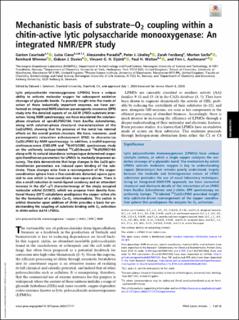| dc.contributor.author | Courtade, Gaston | |
| dc.contributor.author | Ciano, Luisa | |
| dc.contributor.author | Paradisi, Alessandro | |
| dc.contributor.author | Lindley, Peter J. | |
| dc.contributor.author | Forsberg, Zarah | |
| dc.contributor.author | Sørlie, Morten | |
| dc.contributor.author | Wimmer, Reinhard | |
| dc.contributor.author | Davies, Gideon J. | |
| dc.contributor.author | Eijsink, Vincent | |
| dc.contributor.author | Walton, Paul H. | |
| dc.contributor.author | Aachmann, Finn Lillelund | |
| dc.date.accessioned | 2020-08-26T07:30:50Z | |
| dc.date.available | 2020-08-26T07:30:50Z | |
| dc.date.created | 2020-08-10T09:58:09Z | |
| dc.date.issued | 2020 | |
| dc.identifier.issn | 0027-8424 | |
| dc.identifier.uri | https://hdl.handle.net/11250/2674027 | |
| dc.description.abstract | Lytic polysaccharide monooxygenases (LPMOs) have a unique ability to activate molecular oxygen for subsequent oxidative cleavage of glycosidic bonds. To provide insight into the mode of action of these industrially important enzymes, we have performed an integrated NMR/electron paramagnetic resonance (EPR) study into the detailed aspects of an AA10 LPMO–substrate interaction. Using NMR spectroscopy, we have elucidated the solution-phase structure of apo-BlLPMO10A from Bacillus licheniformis, along with solution-phase structural characterization of the Cu(I)-LPMO, showing that the presence of the metal has minimal effects on the overall protein structure. We have, moreover, used paramagnetic relaxation enhancement (PRE) to characterize Cu(II)-LPMO by NMR spectroscopy. In addition, a multifrequency continuous-wave (CW)-EPR and 15N-HYSCORE spectroscopy study on the uniformly isotope-labeled 63Cu(II)-bound 15N-BlLPMO10A along with its natural abundance isotopologue determined copper spin-Hamiltonian parameters for LPMOs to markedly improved accuracy. The data demonstrate that large changes in the Cu(II) spin-Hamiltonian parameters are induced upon binding of the substrate. These changes arise from a rearrangement of the copper coordination sphere from a five-coordinate distorted square pyramid to one which is four-coordinate near-square planar. There is also a small reduction in metal–ligand covalency and an attendant increase in the d(x2−y2) character/energy of the singly occupied molecular orbital (SOMO), which we propose from density functional theory (DFT) calculations predisposes the copper active site for the formation of a stable Cu–O2 intermediate. This switch in orbital character upon addition of chitin provides a basis for understanding the coupling of substrate binding with O2 activation in chitin-active AA10 LPMOs. | en_US |
| dc.language.iso | eng | en_US |
| dc.publisher | National Academy of Sciences | en_US |
| dc.relation.uri | https://www.pnas.org/content/early/2020/07/27/2004277117.full | |
| dc.rights | Navngivelse 4.0 Internasjonal | * |
| dc.rights.uri | http://creativecommons.org/licenses/by/4.0/deed.no | * |
| dc.title | Mechanistic basis of substrate–O2 coupling within a chitin-active lytic polysaccharide monooxygenase: An integrated NMR/EPR study | en_US |
| dc.type | Peer reviewed | en_US |
| dc.type | Journal article | en_US |
| dc.description.version | publishedVersion | en_US |
| dc.source.journal | Proceedings of the National Academy of Sciences of the United States of America | en_US |
| dc.identifier.doi | 10.1073/pnas.2004277117 | |
| dc.identifier.cristin | 1822317 | |
| dc.relation.project | EU/722390 | en_US |
| dc.relation.project | Norges forskningsråd: 269408 | en_US |
| dc.relation.project | Andre: BB/L001926/1 | en_US |
| dc.relation.project | Novo Nordisk Fonden: NNF18OC0032242 | en_US |
| dc.relation.project | Norges forskningsråd: 226244 | en_US |
| dc.description.localcode | Copyright © 2020 the Author(s). Published by PNAS. This open access article is distributed under Creative Commons Attribution License 4.0 (CC BY). | en_US |
| cristin.ispublished | true | |
| cristin.fulltext | original | |
| cristin.qualitycode | 2 | |

